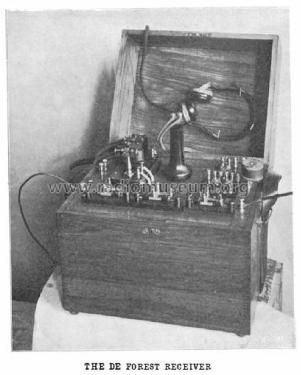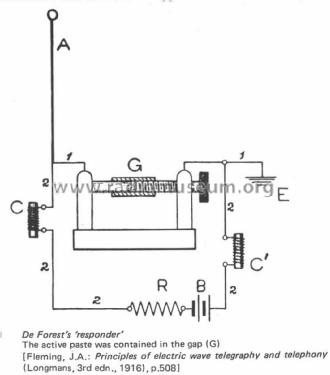Electrolytic Anti-Coherer DeForest-Smythe
DeForest Radio Telephone & Telegraph Co. (De Forest); New York
- Land
- USA
- Hersteller / Marke
- DeForest Radio Telephone & Telegraph Co. (De Forest); New York
- Jahr
- 1899–1901 ?
- Kategorie
- Radio Baugruppe vor 1926 (kein Bauteil, keine Taste)
- Radiomuseum.org ID
- 278969
-
- anderer Name: Lee De Forest Mfg.
- Hauptprinzip
- Spezialschaltung (siehe Bemerkungen)
- Wellenbereiche
- - ohne
- Betriebsart / Volt
- Akku und/oder Batterie
- Lautsprecher
- - Für Kopfhörer oder NF-Verstärker
- Material
- Diverses Material
- von Radiomuseum.org
- Modell: Electrolytic Anti-Coherer [DeForest-Smythe] - DeForest Radio Telephone &
- Form
- Tischmodell, Zusatz nicht bekannt - allgemein.
- Bemerkung
-
In late 1900, along with W.W. Smythe, de Forest took out a patent for adetector, and called it “the Electrolytic Anti-Coherer.”This detector was constructed like the filing coherer used by Marconi. There were two metal plugs contained in an insulated tube with a gap of about 1/100 inch between them. The gap was filled with one of several mixtures the inventors refered to as "goo". A typical mixture consisted of lead oxide, glycerine, water and metal fillings. The fillings were intended to act as secondary electrodes within the gap. Under the influence of a locally applied direct voltage crystalline lead is produced in such a paste and this builds up into chains and trees across the gap, like the silver particles in Schafer's plate. When a chain is completed deposition ceases as the gap is effectively short circuited. Once again a received pulse of oscillations breaks the chain causing a click to be heard in the telephone receiver which may be connected in the battery circuit.
- Literaturnachweis
- Western Electrician, July 27, 1901, pages 49-50
- Autor
- Modellseite von Alan Larsen angelegt. Siehe bei "Änderungsvorschlag" für weitere Mitarbeit.
- Weitere Modelle
-
Hier finden Sie 158 Modelle, davon 133 mit Bildern und 16 mit Schaltbildern.
Alle gelisteten Radios usw. von DeForest Radio Telephone & Telegraph Co. (De Forest); New York

